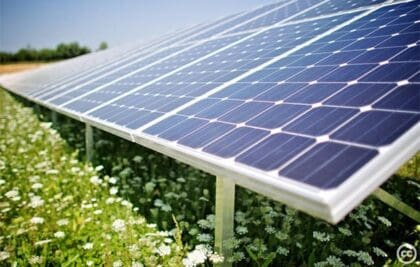
The outcome of the fifth allocation round (AR5) for solar is rather better than had anticipated, illustrating its resilience to economic turbulence compared to offshore wind, for which no bids were made.
A total of 95 winning bids were made across wind, solar PV, remote island wind, geothermal and tidal stream sectors. Solar’s administrative strike price, indexed to 2012, came in at £47 per megawatt-hour, just under onshore wind’s, at £52. Less well-established geothermal and tidal stream technologies secured contracts at £119 and £198 respectively.
Solar farms only became eligible for CfDs in the fourth allocation round (AR4), which concluded in July last year. Of the 93 projects supported in 2022, 63 were photovoltaic, with an anticipated installed capacity coming to 2,209MW.
Pace of installations needs to double
“We are pleased that so many solar projects have been successful in AR5, particularly as solar has only recently been able to participate.
“This shows how resilient solar has become to economic shocks. It remains the cheapest way to generate power in the UK. That said, we need to be roughly doubling the pace of solar installations to meet the Government’s capacity target of 70GW by 2035,” said Chris Hewett, chief executive of Solar Energy UK.
“CfDs are far from the only route to market for utility-scale solar. Some developers will prefer to sell on a merchant basis or seek a long-term power purchase agreement. The AR5 results are therefore not a cap on deployment of solar farms, and we are seeing record high rooftop solar installation in 2023,” he added.
Scheme must increase deployment of all renewables
The absence of contracts for offshore wind power is clearly an indication that AR5 was unbalanced, the result of inflationary pressures on the renewables industry falling much harder on that sector compared to solar.
“We need to be confident that the CfD regime creates a market for all renewables. So, the design of this round has not been as successful as it should have been,” Hewett added.
Considering the vastly lower cost of renewables compared to gas generation, Solar Energy UK would like to see changes made to increase the deployment of all renewables in the AR6 round next year. This should in turn increase the deployment of grid-scale energy storage systems.
Recommendations
Solar Energy UK has 5 key recommendations to improve future CfD rounds to better support the development of solar and storage projects:
- Auctions should be held at least annually: Multiple independent analyses have shown that it will not be possible to deliver the capacity of renewable generation needed to achieve net zero by 2050 if auctions are only held once every two years. Regular solar auctions are needed to send a clear signal to investment markets and to better align with the rapid pace of solar development.
- Robust budget and capacity caps for Pot 1: It is the association’s view that there should be no need for a capacity cap for Pot 1 technologies. A budgetary cap only should be all that is necessary to create the desired competitive tension, and this should be set high enough for established technologies to deliver a clear signal of the volume of capacity that is needed. If capacity caps are imposed, the association recommends at a minimum Pot 1 capacity caps targeted to deliver between 1.5-2GW of additional solar capacity annually.
- Certainty of continued access to CfDs: A one-off allocation round for solar projects, as happened previously, creates uncertainty and will not generate the pipeline of projects needed to meaningfully advance the Government’s decarbonisation objectives. Certainty regarding the continued availability of the CfD mechanism will increase the cumulative capacity of solar projects bidding into CfDs, which in turn will increase strike-price competition and deliver benefits to consumers, alongside increased renewable energy deployment.
- Well targeted Administrative Strike Prices: It is essential that the Government set the ASP for solar at an appropriate level to balance competitiveness with net zero objectives.
- Increased access for co-located solar and storage: Promoting co-located projects via CfDs could have system wide benefits, as well as those which flow directly to the developer and consumers. Defining co-located solar and storage projects as an eligible technology would remove a major barrier for storage in accessing CfDs.